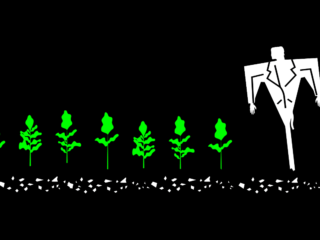A lockdown veg patch *is* worth starting – whatever some commentators say

Christian WoodHas it happened to you yet? The moment when you realise most of your friends, who wouldn’t normally know their asters from their onions, are posting pictures of themselves standing by some mud with a fork, or pointing at a basil plant in a yoghurt pot? The moment when your former boss, a metropolitan media exec, emails not to check whether you’ve seen the latest from Trump, but to ask if you have any spare seed potatoes?
Yep, in lockdown the entire world has taken up veg gardening. Online, the neighbourhood networks are full of posts offering tomato seeds in return for compost, and news websites are stuffed with upbeat pieces about how to grow microgreens on a windowsill or exhorting the population to dig up their lawns for victory. Meanwhile we’ve lost count of the number of Facebook shares we’ve seen claiming you can re-grow a carrot by leaving a decapitated top in a glass of water. (You can’t. You might grow some carrot leaves – but that long orange pointy thing you grated for coleslaw is a tap root, and once it’s gone, it’s gone.)
James Wong, aka @Botanygeek, was mildly damning of all this in his column for The Guardian this Easter weekend. He, like us, is all for people experimenting with growing food at home; he, like us, thinks it’s a healthy, constructive and enjoyable use of time spent in lockdown. But then he gets more sceptical. He makes the entirely true point that growing your own food is hard work, and the (more arguable) one that it is stupidly expensive. But he also pushes the really-there’s-no-point line: referencing that old Felicity Kendall/Richard Briers hit The Good Life, he says the idea of home gardeners trying to achieve any semblance of self-sufficiency is so silly it is “best left to Seventies sitcoms”. (There’s nothing wrong with Seventies sitcoms, by the way. Apart from the fact that there’s only so many times you can laugh at Mrs Slocombe’s pussy. And all men saying “Cor!” and “Phwoar!” at any woman under 50 who walks past can get a tad predictable. As can shouting “Ooh Betty!” as you rollerskate underneath an articulated lorry.)
Anyway, none of this comes as a great surprise: on Twitter, Wong regularly stomps all over suggestions that #growyourown is a realistic alternative to mass production as a way of feeding people. He has his reasons. Wong is a botanist by training, and like anyone with a scientific mind and a more than superficial interest in food production, he’s all too aware of how much time, space and skill it takes to produce useful amounts of food. As a gardening columnist, he’ll know from the BTL comments how far his readers’ expectations of a home veg-patch can veer from reality. And he’s taken the time to test his theories: when he was working at the Royal Botanic Gardens at Kew, he did an experiment to see how many calories he could grow in a suburban garden. Despite his undoubted skills, he says he only managed to grow 1% of his annual calorie needs.
So you can see why he’d say there’s not much point trying to feed yourself from your garden. The trouble is, it’s not the whole story. Wong doesn’t, in his column, say what plants he chose to grow. Or what was the size of the garden he planted. This is a shame – because, as we’ve discussed elsewhere, 146 square metres (that’s three-fifths of the average allotment) planted with nothing but potatoes could in theory provide one adult with 100% of their calories for a year. (Admittedly, after that they’d die of boredom brought on by eating nothing but chips.) So Wong’s veg patch providing only 1% of his annual calorie needs seems pretty low – unless either a) his garden is tiny, or b) Wong is a giant and therefore needs 100 times more calories than the rest of us.
Five from 14
But anyway, let’s set calories aside for a moment and use another calibration: the five-a-day rule. Can you expect your lockdown veg patch to provide you and your family with the five portions –aka 400g – of fruit and veg a day that’s recommended by the UK government? In late March this year, the University of Sheffield’s Institute for Sustainable Food Production (ISFP) published a paper showing that, if Sheffield converted all of its domestic gardens, parks, and allotments to fruit and veg-growing, it could provide 122% of the city’s population with their five a day. Even using a more realistic 10% of that space, it could provide five portions a day for 15% of its population. And it based all this on its initial calculation that 80 square metres of growing space – ie a third of the average allotment – is what it takes to provide five-a-day for one adult for a whole year. As the average UK garden is 14 square metres, that’s enough to provide you with a smidgen less than 20% of your five-a-day needs. Even ignoring calories, that’s a significant step towards keeping you healthy.
Now let’s factor in post-pandemic food security. Never mind growing some of your five a day during these first weeks, we’d put money on the later part of this year being afflicted with odd, apparently random shortages of fruit and veg. Why? As readers of our book will know, imports account for 53% of all the fresh veg sold in the UK, and 84% of the fruit. Covid-19 related disruptions to harvests here and abroad, plus the fact that some countries are already showing a tendency to hoard their own produce rather than export it, will have unpredictable effects on the supermarkets’ just-in-time supply chains. And we’re now a whole lot more familiar with how that plays out.
Keep going with that growing
To get back to Wong’s other two points: growing your own food does indeed take time. Allotment holders spend an average of 45 minutes per square metre per year cultivating their land. Once you’re no longer in lockdown and have to get back to earning a living, turning that much time over to gardening might not be something you can afford to do. Also, growing at home doesn’t benefit from the same economies of scale as mass production on farms, and so can easily end up being more expensive, particularly for cheap crops such as potatoes that are widely grown by UK farmers. And although it may seem counter-intuitive, growing food at home – if done in a high-input way, relying on non-replaceable, shop-bought resources such as inorganic fertilisers, or bags of peat-based compost – may also have a higher carbon cost than buying food from the supermarket. As long as you don’t throw that food away, that is: more than 30% of the carbon emissions of food in Europe is due to shoppers buying food, then chucking it away uneaten. (Not James Wong, obviously. The man is eating a lot.)
But when UK farmers aren’t growing enough fruit and veg to meet our needs, when workforce numbers are hit by Covid-19 and supply chains from overseas are looking sickly, and when our towns and cities are full of gardens that are more than capable of growing at least some of our food, it’s worth getting that spade out and starting to dig. On its own, #growyourown gardening is unlikely to keep you alive, but it can help.
So keep going with that growing. You never know, someone might write a sitcom about it.









